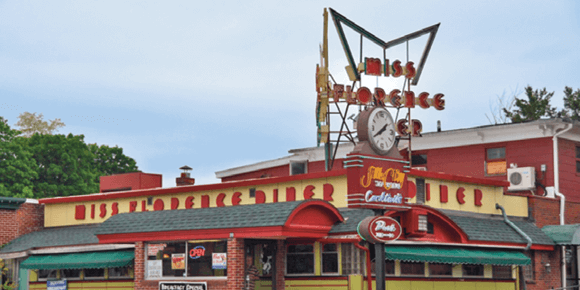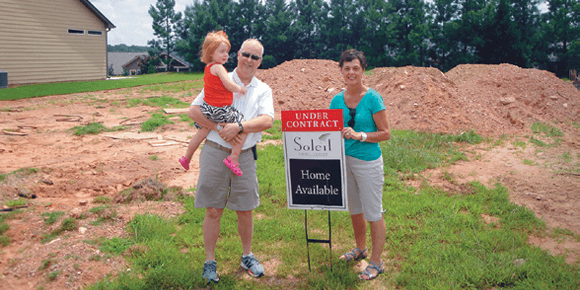The mechanics of marketing homes in gentrifying, ethnic, retirement and unfamiliar neighborhoods.
 Gentrifying
Gentrifying
Steve Westmark, CRS, is always tracking data and trends, in his area and nationally, and he shares that information with potential clients through weekly video blogs. In a recent video, he discussed national REALTOR® confidence data from the National Association of REALTORS®, bringing in local statistics as well.
Craig Della Penna, CRS, became a REALTOR® after working in the railroad industry and then for a nonprofit that turns old rail lines into walking and biking trails. So it makes sense that he works in the Pioneer Valley in Northampton, Massachusetts, an area thats turning old railroad corridors into linear parks.
Given his background, Della Penna markets himself as an expert in converted railroad lines and the villages that surround them. He also runs a bed and breakfast in Northampton. I get several real estate transactions a year from people who love this area so much they want to relocate here.
Lea Ellison, CRS, focuses on the historic and downtown areas, so she runs ads in a historic district church directory and in museum and event programs. She also lists her properties using the terms she knows are buzzwords to her potential clients. When you use keywords on social media, whatever architectural terms apply to the house, make sure they are in your search engine optimization (SEO) list, she says.
When Ellison is representing the seller of a renovated home, she asks him or her to make a spreadsheetshe provides an exampleof everything done to the house along with the date and the cost. We can add up all those costs, which tells them the value added to the property, and then we price to market, Ellison says. She also puts that spreadsheet in the document section of the MLS listing so its accessible to agents and appraisers.
Being on the cutting edge of a gentrifying neighborhood is a valuable place to be. It takes some legwork and vision, but its not necessarily hard to get intelligence on the next breakout neighborhood. People love talking about real estate, says MaryKay Shumway, CRS, and they love real estate gossip.
Read more about gentrifying areas.
Neighborhood Watch: Florence, Northampton, MASS
When industrial mills were the economic engine of this area, housing sprung up nearby for the workers. As the mills shut down, some neighborhoods fell into disrepair and are only now being rejuvenated.
For example, an old sewing machine factory in the village of Florence in Northampton, Massachusetts, now houses a medical office and more than 25 small businesses. A late-1800s general store has been converted into a pie bar. And buyers are updating housing in the surrounding area.
The next generation is coming in, and they want to live close to town, says Craig Della Penna, CRS, associate broker of The Murphy’s REALTORS® in Northampton. People want to live in traditional neighborhoods.

The historic Miss Florence Diner in Florence, Northhampton, Massachusetts.
Marketing yourself in traditionally ethnic neighborhoods may be a careful dance with whats legally and ethically acceptable, but that doesnt mean it cant be done.
Eloise Gift, CRS, broker and owner of Gift Realty NM in Albuquerque, New Mexico, always starts the search with price, which is typically her buyers No. 1 concern anyway, and uses that to guide her search. This naturally opens up her search to new neighborhoods. Its therefore important to stay on top of how all these traditionally ethnic neighborhoods are changing.
Its also important that her GPS is always ready to rock.
We have to drive through the neighborhood, look at the homes, watch people on the streets and get a feel for the community, Gift says. It can make a big difference in a clients willingness to consider a neighborhood they once thought was off limits, she explains.
This exact scenario played out when she was recently working with a senior couple that was surprised when she suggested they look at a home in a particular neighborhood. They had a negative preconception about this communitybut their assumption was based on outdated information. They had avoided the neighborhood for decades and had no idea how the neighborhood had blossomed. So in many ways, the most important part of my job is to educate clientsintroduce them to all the neighborhoods that fit their criteria.
At the end of the day, buying a house is about many different factors that ultimately dictate what a client will buy, and its important for an agent to consider all of them.
41%
of the total buyers market.
Denise ONeil, CRS, has been selling real estate in the South Bay area of Los Angeles since 1987. After many years in the business, my clients are older, she says, and the majority of them today are generated by referrals. Michael McAleer, CRS, says he engages in the same marketing activities as many REALTORS®; he lists offerings on Zillow and maintains an informative website. Yet most of his business is from referrals. Last year, 72 percent of sales were based on other people saying I did a good job for them.
Susanne McInerney, CRS, provides her senior clients a five-step program for moving into retirement living, which starts with seniors learning about what options are available in the area. If a senior goes online, they cant find a list, she says, so I help them learn what their options are.
One of the biggest challenges for seniors of any age moving into retirement living is the need to downsize. They may have lived somewhere for 20 or 30 years and accumulated furniture and objects they dont want to part with, says Ben Staten, CRS. Theres no way they can move all of their belongings. We have to give them different ideas about how they might repurpose.
Clients are also advised to donate, discard, give to family members or sell off some pieces before moving, and they are directed to agencies that can assist them.
Downsizing requires most seniors to make difficult decisions at what can be a particularly vulnerable time. McInerney conducts a seminar series that she licensed through the Seniors Real Estate InstituteDownsizing Made Easy: Five Easy Steps to Simplify Your Move. While sorting through possessions, choosing a new place to live, and deciding what to take and what to leave, it suddenly hits them that downsizing is a lot of work, she adds. The seminar has become one of her best ways to attract new clients.
When Lisa Weissgarber Harder, CRS, visited one of her downsized clients, she was offered soda in a crystal glass. When I tried to object, she told me that was all she had, she says. Ill never forget her telling me that every day is a celebration when you get old. All these years, she told me, I never used this stuff except for birthdays and holidays. Now I use it every day.
One Photo Is Worth

Alan and Lauren Lodwick with their granddaughter at the site of their new home.
When he goes through the building process with clients, Ben Staten, CRS, at Red Hot Atlanta Homes in Woodstock, Georgia, takes pictures of the house as it is being built, especially for out-of-state clients. One couple, Alan and Lauren Lodwick, was moving to the Gainesville area to be close to their children and grandchildren. On the day they met Staten at the site to finalize their contract, they brought along their granddaughter. Staten took their photo and included it with other photos showing progress. At the closing, Alan Lodwick told Staten that at the time he hadnt thought much about it. But when that photo came up on the virtual tour, he said he knew why he had gone through the whole process, and it was definitely worth it.
Finding the right marketing mix that will make local clients feel comfortable is different for each area. Betsy Pepine, CRS, uses newsletters, email blasts and community events. She sponsors a well-known community Easter egg hunt, as well as ice cream socials for clients.
Kristin Walter used a personal touch, going door-to-door in her community and getting involved in local groups. She also used postcard and newsletter mailings to reach targets.
In 2010, Pat Tasker, CRS, created Facebook pages for each of the subdivisions she was targeting and maintained them as information sources. Most content she posted was community and neighborhood information with some real estate news and open houses, positioning herself as the go-to source for both regional real estate and neighborhood information. She also used more traditional methods, such as buying advertising space on supermarket shopping carts for more mass-market reach.
Nicole Smith, CRS, also uses an informational approach with her clients, focusing on useful content rather than self-promotion in her postcards, newsletters and email marketing. Instead of pick me because Im No. 1, her approach is, Here is some useful information, call me if I may be of service, she says.
While its tough to directly attribute ROI to one task in a multifaceted marketing effort, Pepine says that consistency is critical. Pick communities that turn over frequently and be consistent with your marketing17 touches per yearfor two years before making an evaluation. The goal is to have 50 percent of the listings in the area in two years, she says. The size you target depends on your comfort level. New agents should start at 300 to 500 homes to be able to effectively and consistently market, while more established agents with larger budgets can manage areas with as many as 10,000 or more homes, she says.
Breaking into a new market is possible. With a steady effort that includes research, marketing and community involvement, REALTORS® can tap new markets near or far.
Whats your best advice for CRS agents getting started in a new area? Start a discussion at CRS.com.
The Power of Doing Good

After Pat Tasker, CRS, with Shorewest Realtors in Menomonee Falls, Wisconsin, shifted her focus from Milwaukee to the suburb where she lives, she got involved with local organizations in the community. Tasker was particularly moved by the tragic story of a local young woman who died of a heroin overdose and immediately looked for ways to help others who might be at risk.
She became involved with her local Big Brothers Big Sisters chapter. She was paired with a local elementary school student and met her little sister at the school weekly. Tasker and her little sister spent more time at the school, learned about its strengths and met new people in the community through her service.
Even though I lived in the community, getting involved with this organization led to new contacts I never would have made because I didnt have children in the school. Its certainly not why I got involved, but it was an unexpected benefit, she says. {/tabs}







